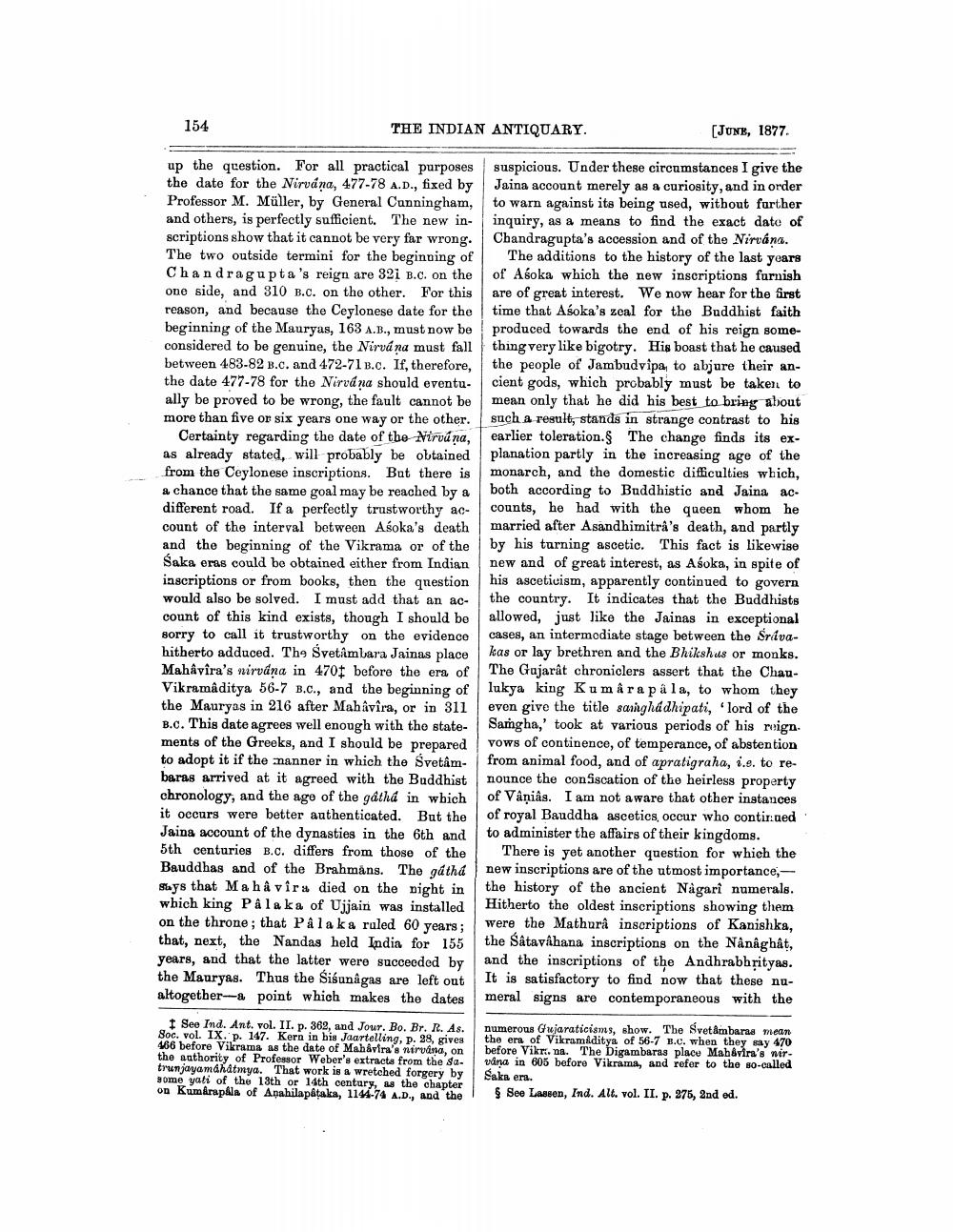________________
154
THE INDIAN ANTIQUARY.
(JUNE, 1877.
up the question. For all practical purposes suspicious. Under these circumstances I give the the date for the Nirvana, 477-78 A.D., fixed by Jaina account merely as a curiosity, and in order Professor M. Müller, by General Cunningham, to warn against its being used, without further and others, is perfectly sufficient. The new in- inquiry, as a means to find the exact date of scriptions show that it cannot be very far wrong. Chandragupta's accession and of the Nirvana. The two outside termini for the beginning of The additions to the history of the last years Chandragupta's reign are 321 B.C. on the of Asoka which the new inscriptions furnish one side, and 310 B.C. on the other. For this are of great interest. We now hear for the first reason, and because the Ceylonese date for the time that Asoka's zoal for the Buddhist faith beginning of the Mauryas, 163 A.B., must now be produced towards the end of his reign someconsidered to be genuine, the Nirvana must fall thing very like bigotry. His boast that he caused between 483-82 B.C. and 472-713.c. If, therefore, the people of Jambudvipa, to abjure their anthe date 477-78 for the Nirvana should eventu- cient gods, which probably must be taken to ally be proved to be wrong, the fault cannot be mean only that he did his best to bring about more than five or six years one way or the other. such a result, stands in strange contrast to his
Certainty regarding the date of the Nirvúna, earlier toleration. The change finds its exas already stated, will probably be obtained planation partly in the increasing age of the from the Ceylonese inscriptions. But there is monarch, and the domestic difficulties which, a chance that the same goal may be reached by a both according to Buddhistic and Jaina acdifferent road. If a perfectly trustworthy accounts, he had with the queen whom he count of the interval between Asoka's death married after Asandhimitra's death, and partly and the beginning of the Vikrama or of the by his turning ascetic. This fact is likewise Saka eras could be obtained either from Indian new and of great interest, as Asoka, in spite of inscriptions or from books, then the question his asceticism, apparently continued to govern would also be solved. I must add that an ac- the country. It indicates that the Buddhists count of this kind exists, though I should be allowed, just like the Jainas in exceptional sorry to call it trustworthy on the evidence cases, an intermodiate stage between the Srivahitherto adduced. The Svetamlara Jainas place kas or lay brethren and the Bhikshus or monks. Mahâvîra's nirvana in 4701 before the era of The Gajarât chroniclers assert that the ChauVikramaditya 56-7 B.C., and the beginning of lukya king Kumâra på la, to whom they the Mauryas in 216 after Mahîvîra, or in 311 even give the title sannghadhipati, 'lord of the B.c. This date agrees well enough with the state- Samgha,' took at various periods of his reign. ments of the Greeks, and I should be prepared vows of continence, of temperance, of abstention to adopt it if the manner in which the Svetâm- from animal food, and of apratigraha, i.e. to rebaras arrived at it agreed with the Buddhist nounce the con Siscation of the heirless property chronology, and the age of the gåtha in which of Vâņiâs. I am not aware that other instances it occurs were better authenticated. But the of royal Bauddha ascetics, occur who continued Jaina account of the dynasties in the 6th and to administer the affairs of their kingdoms. 5th centuries B.C. differs from those of the 1 There is yet another question for which the Bauddhas and of the Brahmans. The gåthánew inscriptions are of the utmost importance, - Slays that Maha virs died on the night in the history of the ancient Någari numerals. which king Palaka of Ujjain was installed Hitherto the oldest inscriptions showing them on the throne; that PAlaka ruled 60 years; were the Mathura inscriptions of Kanishka, that, next, the Nandas held India for 155 the Satavahana inscriptions on the Nânâghất, years, and that the latter were succeeded by and the inscriptions of the Andhrabhrityas. the Mauryas. Thus the Sisunagas are left out It is satisfactory to find now that these nualtogether-& point which makes the dates meral signs are contemporaneous with the
I See Ind. Ant. vol. II. p. 362, and Jour. Bo. Br. R. As. Soc. vol. IX. p. 147. Kern in bis Jaartelling, p. 38, gives 466 before Vikrama as the date of Mahavira's nirvana, on the authority of Professor Weber's extracts from the sa. trunjayamahatmya. That work is a wretched forgery by some yati of the 13th or 14th century, as the chapter on Kumarapala of Anahilapataka, 1144-74 A.D., and the
numerous Gujaraticisms, show. The Svetambaraa mean the era of Vikramiditya of 56-7 B.C. when they say 470 before Vikr. na. The Digambaras place Mahavira's wir. vana in 605 before Vikrama, and refer to the so-called Saks era.
$See Lassen, Ind. Alt. vol. II. p. 375, 2nd ed.




